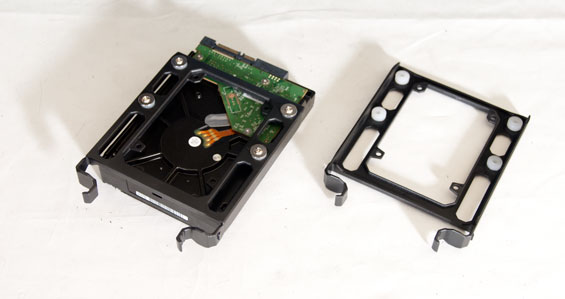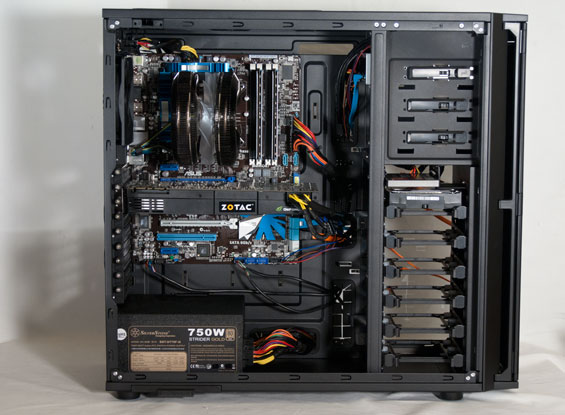Antec P280 Review: When Enthusiasts Are Engineers
by Dustin Sklavos on November 15, 2011 10:20 AM EST- Posted in
- Cases/Cooling/PSUs
- Antec
- P280
Assembling the Antec P280
If you ever dreaded assembling or working in Antec's P180 series, the P280 is going to seem like a breath of fresh air. The interior is incredibly spacious, but not just that...Antec has produced an enclosure that is nearly as easy to work inside as any of Corsair's (still the standard for ease of assembly as far as I'm concerned.)
The two side panels are held on by thumbscrews and are extremely easy to remove. From there, Antec has included six mounting screws for the motherboard and includes the rest in a kit with the enclosure. Our I/O shield snapped into place easily enough, and the board went in without any fuss. Wiring things up was a little bit trickier; it would've been nice if Antec had routed the cables through the motherboard tray in the first place and bound the motherboard headers together, but once you do it yourself the inside feels a lot cleaner.

As for mounting drives, that's more of a mixed bag. I had to pretty much jimmy the optical drive in, applying force until it eventually just went all the way in. On the flipside, the toolless locking mechanism is incredibly secure (although you can still use screws if you're so inclined.) This is still a big improvement over having to manually attach rails to the ODD. The 3.5" drive trays are sturdy enough, though remember to stash the screws in a safe place for when you want to add additional drives. Where things do get a bit tricky is in the 2.5" toolless cage: SSDs slide in pretty firmly (I'd really recommend against putting a mechanical drive in here), but it doesn't feel super secure, and you'll want to route cables through the cage ahead of time as it's difficult to access the back of the drive from the other side. There's no locking mechanism either, just the pressure of the cage on the sides of the SSD, although you can use a screw to mount them in place. If you're not a fan of this approach (and I wouldn't fault you), it's worth mentioning 2.5" drives can also be mounted on the drive trays.

Mounting the power supply and video card was easy enough; there's a healthy amount of space inside the enclosure, and things lined up just fine. Where Antec has made their biggest gains, however, is in cable organization. The P180 really pioneered cable management back in the day but by modern standards it's pretty dire. That's not the case with the P280, where there's nearly enough space behind the motherboard tray to stand up a molex connector on its side. Wiring up the P280 was very easy, with copious space above the tray for the AUX 12V line, and plenty of space around the motherboard to squeeze in the side-mounted SATA cables. I also plugged the three included fans into the set of headers in the back of the case, and routing the single molex power cable was a breeze.
Honestly, the P280 is just tremendously roomy and easy to work in, the polar opposite of its predecessor. With the tremendous amount of space behind the motherboard tray, sliding the back panel on required none of the force it usually does with most other enclosures. This is a design that was clearly put together by engineers who also happened to be enthusiasts, and it really shows.
















164 Comments
View All Comments
fatpat268 - Tuesday, November 15, 2011 - link
"While some people may be a little peeved at losing the dual chamber design of the P180 line, I'm not particularly bothered by it."I'm not. The dual chambered design is the main reason why I want to get rid of my P182. In my experience, the dual chambers have little effect compared to a standard design, but it makes it twice as difficult to assemble.
I'm currently looking at new cases right now, and I'm glad that Antec ditched that design.
Strunf - Tuesday, November 15, 2011 - link
I share the same feeling about the dual chamber design (at least on the P182), it's quite a pain to work on the lower chamber, everything is cramped and you have to be extra careful to not let the cables touch the fan that is in-between the hard drives and the PSU.If there was a easy way to remove the piece of steel separating both chambers I would do it in a heart beat, the case would be much better then...
kmmatney - Tuesday, November 15, 2011 - link
Yep - getting the hard drive cables to not touch the fan can be tricky in the P-182. I still love it, though, just for how quiet it is. I can passively cool my HD4890 using only one case fan (and the hard drive fan) for an almost completely silent system. Glad to see the improvements, though.MrSpadge - Tuesday, November 15, 2011 - link
After some time I removed the fan in the lower chamber. I've got only one HDD and the PSU is 80+ Gold (now), so I don't it any more. Still cramped, but much easier.MrS
TeachPA - Wednesday, November 16, 2011 - link
I kind of liked my dual chamber 180. It was pain but once my cables were secure it didn't cause any problems.rrohbeck - Wednesday, November 16, 2011 - link
Look at the Define XL by Fractal Design.I just bought one and it's great. It has two chambers too, but done right without a fan in the way. And it doesn't have the fans in the top so it's quieter - much better as long as you don't want watercooling or manual fan control. I don't.
The one thing that the Antec has that I want is the double hinged door. Otherwise the Define XL is nicer and it has plenty of cooling with two additional fans. Enough to overclock the heck out of a Bulldozer with a NH-D14 anyway and it's still quiet.
kasakka - Thursday, November 17, 2011 - link
I've got the Define R3 and it has some issues like hard to close side plate, side plate screws not mounted on the plate itself (like they were on the Antec P150), too small reset button and a bit fiddly cable routing.It's not a bad case but not a great one either. Personally I really loved the Antec P150 except it had a poor quality power/reset button (easily breaking plastic) and couldn't fit full length graphics cards without taking a hacksaw to some parts.
geniekid - Tuesday, November 15, 2011 - link
I wonder a little bit about the CPU cooler. Would a cooler with a different configuration work better with some of these cases?I understand it's important to keep things consistent across different cases, but I can't help but think that cases that do such a good job of ambient cooling (R3, P280) should have no problem with a CPU that has it's OWN cooler attached to it already. It makes me think the CPU cooler isn't doing it's job properly.
geniekid - Tuesday, November 15, 2011 - link
"It makes me think the CPU cooler isn't doing it's job properly." Or, alternatively, that the case may have been designed with another CPU cooler in mind.Dribble - Tuesday, November 15, 2011 - link
Looking at the case it looks like cool air comes in at the front + bottom, turns 90 degrees gets heated by the gpu and then probably wants to exit mostly out the top which is blowing accross the cpu a bit. Another design of cooler might take a degree or two off.That said the gpu gets lots of cool air, and being as these days that's the hottest thing in the pc you could argue that it's now more important to cool then the cpu.